Cascadia Research is undertaking a field project off the island of O‘ahu from October 10-24, 2010. Although we’ve worked off all the main Hawaiian Islands, this is the first field project we’ve had off O‘ahu since 2003. Our primary goals for this project are to obtain information on movements and habitat use of a number of species of toothed whales through the deployment of satellite tags, but we will also be obtaining photos and biopsy samples (for toxicology and genetic studies) from most species of odontocetes we encounter. Species that we are hoping to satellite tag include false killer whales, short-finned pilot whales, melon-headed whales, pygmy killer whales, Cuvier’s beaked whales, and Blainville’s beaked whales.
The research team includes Greg Schorr, Daniel Webster, Jessica Aschettino and Robin Baird of Cascadia and a number of volunteers. This work is being funded by grants from the Naval Postgraduate School (funded by N45) and the Pacific Islands Fisheries Science Center.
For more information see our Hawai‘i odontocete research page
Sign up to our Facebook page if you want to receive notices of when information is posted and updates on other Cascadia projects.
The most recent updates are at the top of the page
October 24, 2010
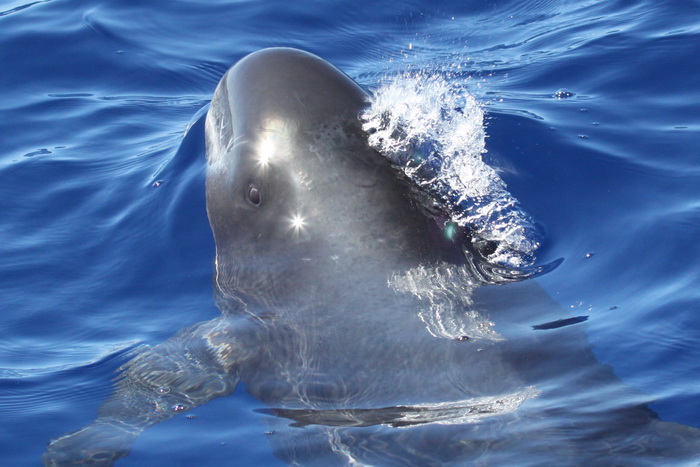
Pygmy killer whale, October 24, 2010. Photo by Jessica Aschettino.
Today was our last day on the water for this trip. We were on the water 14 of the last 15 days, and covered 1,501 kilometers of trackline off the south and southeast short of Oahu. We had 30 sightings of 10 species of odontocetes, collected 32 biopsy samples for genetics and toxicology studies, took 18,666 photos for individual photo-identification, and deployed 12 satellite tags. Today we encountered a different group of pygmy killer whales than the one we saw last week, and were able to photo-identify all 24 individuals present, and deploy a satellite tag to track movements.
Our next field project will start in just weeks (early December) off the island of Hawaii – check out our projects page for updates starting December 5th.
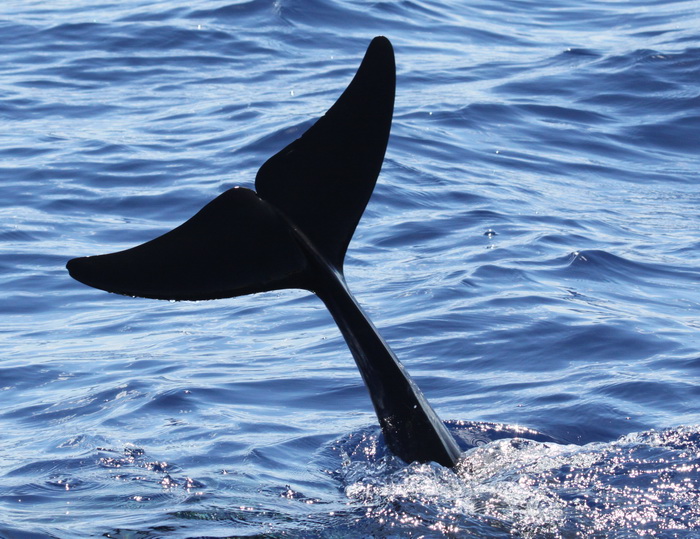
Pygmy killer whale waving tail in air. Photo by Jessica Aschettino.
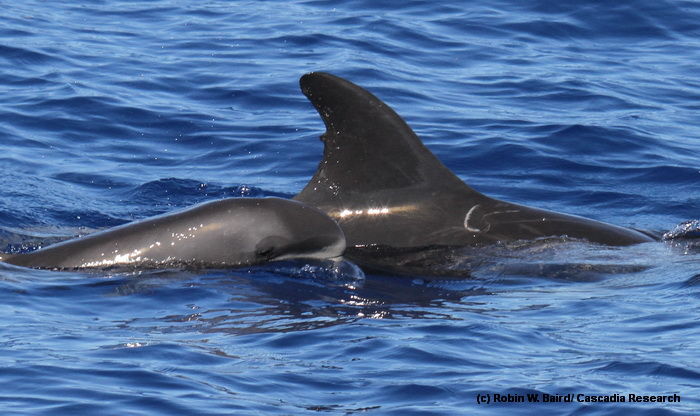
Pygmy killer whale mother and juvenile. Photo by Robin Baird.

Pygmy killer whales adults, photo by Kelly Wright.
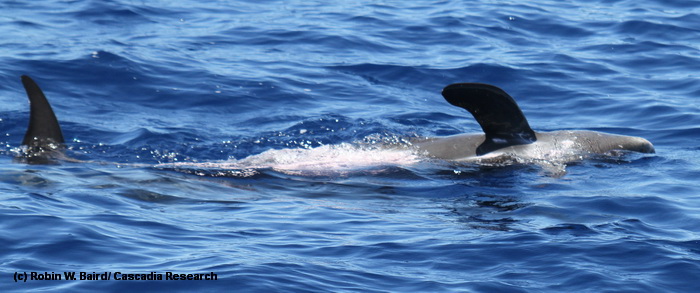
Pygmy killer whale, showing the distinctive rounded flipper of this species. Photo by Robin Baird.

Pygmy killer whales socializing, photo by Daniel Webster.
October 23, 2010
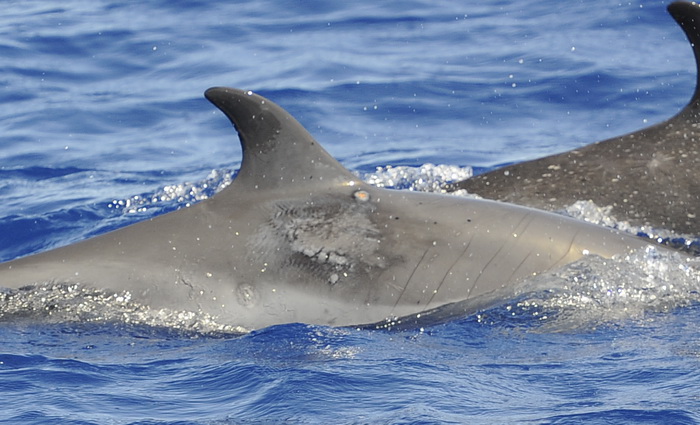
Pantropical spotted dolphin with abrasions below the dorsal fin caused by one or more persistent remoras. Photo by Chuck Babbitt. We are not sure what caused the linear abrasions further forward on the body, although linear marks like this are often caused by propellor strikes.
Today our only cetacean sighting was a group of pantropical spotted dolphins. Several individuals had large remoras and were leaping repeatedly in an attempt to remove the remoras.

Pantropical spotted dolphin leaping to try to get rid of a large remora. Photo by Greg Schorr.

Pantropical spotted dolphin leaping, again, to try to get rid of a large remora. Photo by Daniel Webster. Persistent remora damage can be seen on the right side of this individual below the dorsal fin.
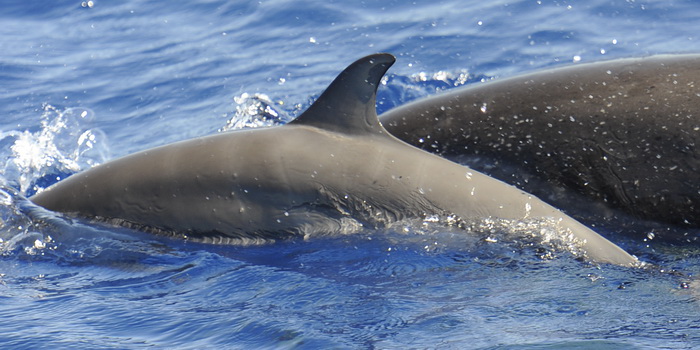
Pantropical spotted dolphin calf with “neonatal folds”, the light vertical bands along the side of the body. Photo by Chuck Babbitt. Such light bands occur due to the folding of the fetus in utero, although this individual is probably several months old, given the evidence of healing of a likely cookie-cutter shark bite wound on the dorsal fin.
October 22, 2010
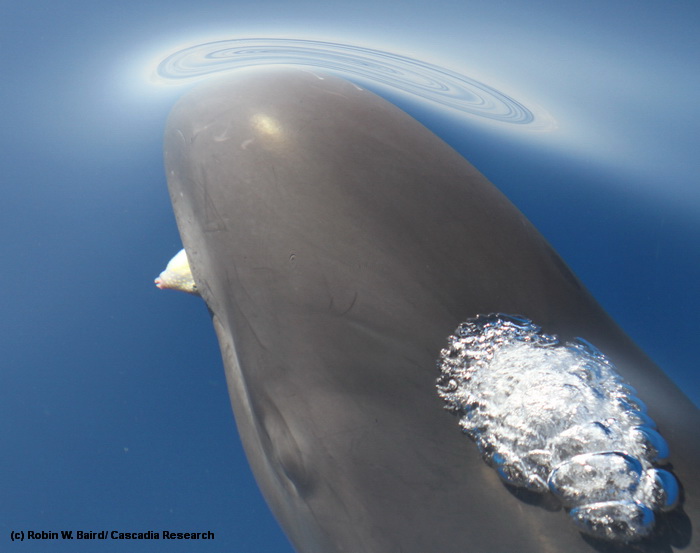
A false killer whale with a crowned pufferfish, October 22, 2010. Photo by Robin Baird. This individual dropped the fish and another juvenile behind it grabbed the pufferfish, then later dropped it and we were able to collect the pufferfish to confirm the species.
Today we encountered our second group of false killer whales for the trip. We recognized many of the individuals from the resident (Hawai‘i insular) population, were able to photo-identify about 19 individuals, collected one biopsy sample for genetics and toxicology, and deployed two additional satellite tags, including one of the location/dive tags.

False killer whale mother and calf, October 22, 2010. Photo by Robin Baird.
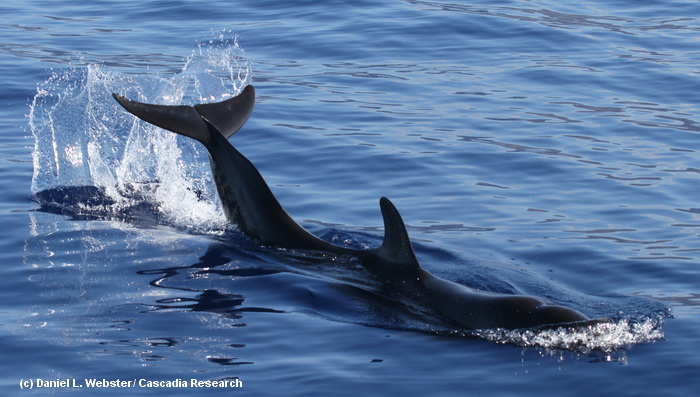
Juvenile false killer whale tail lobbing, October 22, 2010. Photo by Daniel Webster.
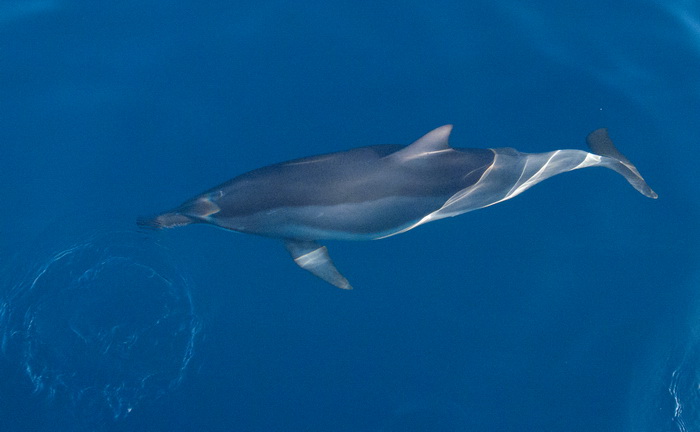
Spinner dolphin, October 22, 2010. Photo by Jonas Webster.
We also encountered a group of spinner dolphins, our second group of this species this trip.

Group of spinner dolphins bowriding, October 22, 2010. Photo by Jonas Webster.
October 20 and 21, 2010
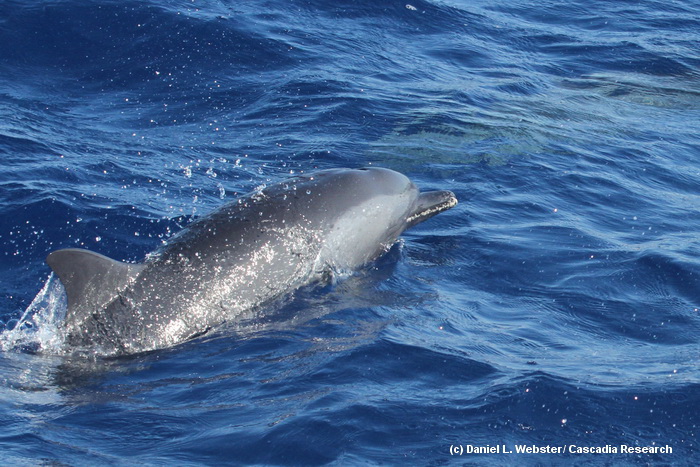
Pantropical spotted dolphin, October 20, 2010. Photo by Daniel Webster.
In the last two days we encountered another group of Blainville’s beaked whales, several groups of spotted dolphins, and our 10th species of odontocete for the trip, a lone dwarf sperm whale (sadly no photos). Below are maps of movements of two of the species we’ve deployed satellite tags on this trip.
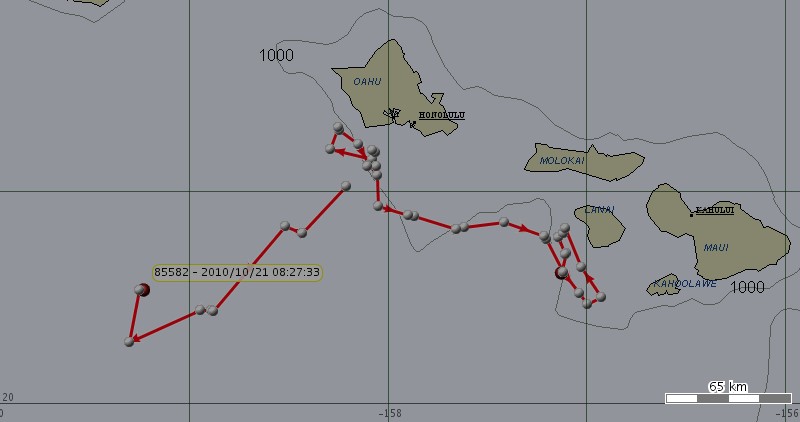
Movements of two of the short-finned pilot whales satellite tagged during this project, as of October 21. One individual (85582 in the map) has moved 140-170 kilometers offshore since tagging on October 19th, while the other has remained close to the islands but has moved to the east off of Lana‘i.
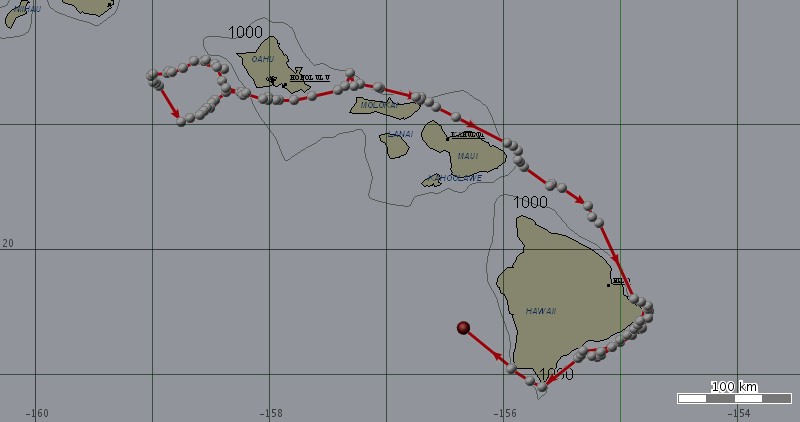
Movements of HIPc200, the false killer whale tagged off O‘ahu October 15th.
October 19, 2010
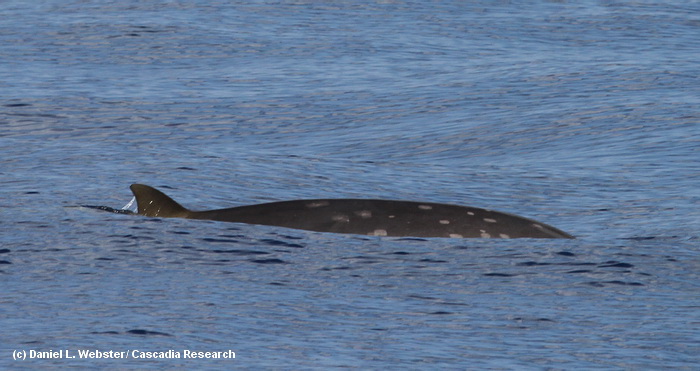
A Blainville’s beaked whale south of O‘ahu, October 19, 2010. Photo by Daniel Webster. The white oval scars on the body are healed scars from cookie-cutter shark bites, which are visible for up to about 10 years on this species.
Today was our 9th day on the water and we encountered our 9th species of odontocete for the trip, a group of three Blainville’s beaked whales. We were able to get identification photos of two of the three individuals but were not able to get close enough to deploy a satellite tag. From work off the island of Hawai‘i we know there is a resident population of this species off that island, but there have been no re-sightings of photo-identified individuals from any of the other islands, so we do not know if these are part of a resident population or an open-ocean population. For more information on Blainville’s beaked whales see our web page for this species.

Short-finned pilot whale spyhopping off O‘ahu, October 19, 2010. Photo by Daniel Webster. We also encountered two groups of short-finned pilot whales about 35 kilometers offshore of the island, with more than 90 individuals.
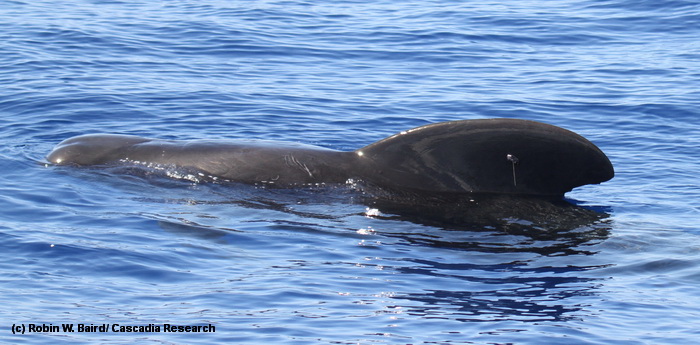
Adult male short-finned pilot whale with satellite tag, October 19, 2010. Photo by Robin Baird. We were able to photo-identify most of the individuals present and also deployed satellite tags on three individuals.
October 18, 2010

Whale shark next to our boat off Waianae, October 18, 2010. Photo by Robin Baird. It took 55,000+ kilometers of trackline over the last 11 years for us to see our first whale shark. Hopefully we won’t have to wait another 11 years!
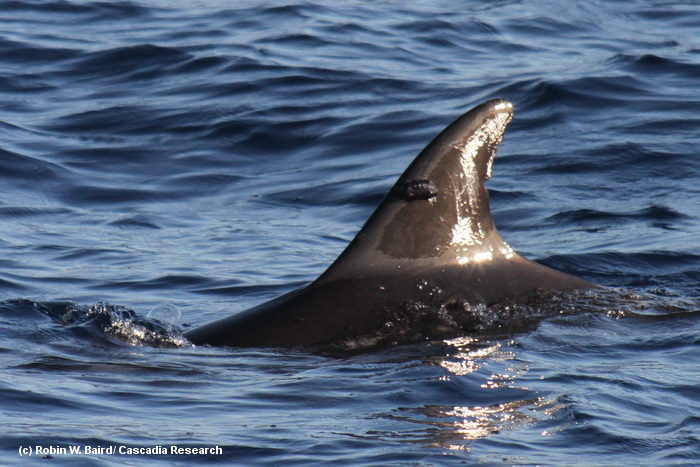
Pygmy killer whale with satellite tag, October 18, 2010. Photo by Robin Baird. Today we re-located the group of pygmy killer whales we encountered last week, and were able to photo-identify all the individuals, obtain three biopsy samples, an acoustic recording, and deploy another satellite tag.
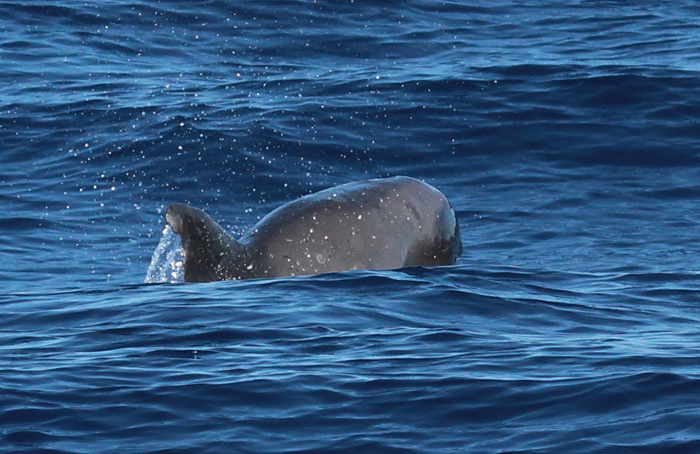
A melon-headed whale off Waianae, October 18, 2010. Photo by Jessica Aschettino. We also sighted our 8th species of odontocete for the trip, a lone melon-headed whale. Normally melon-headed whales travel in groups of several hundred individuals so it was extremely unusual to find a lone individual. For more information on our melon-headed whales in Hawai‘i see our web page for this species.
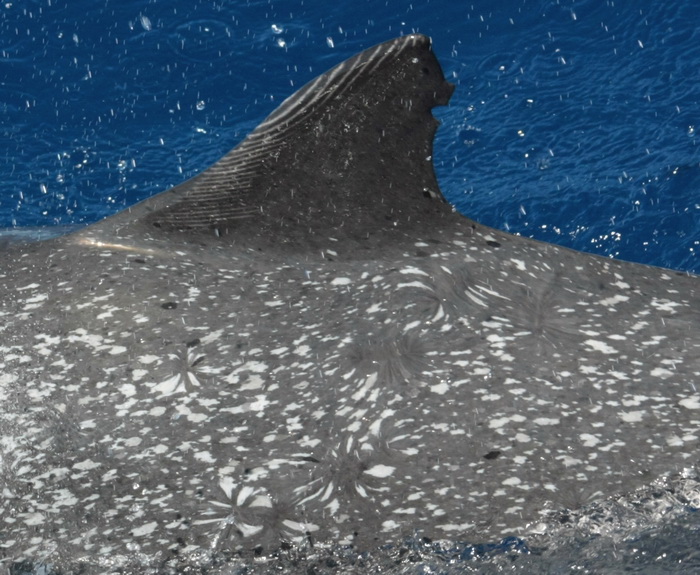
A very well-marked pantropical spotted dolphin, October 18, 2010. Photo by Lisa Schlender. The white linear marks on the dorsal fin are tooth rakes from another spotted dolphin. The complex swirl of white markings on the body are caused by the healing of cookie-cutter shark bites distorting the spotting pattern.
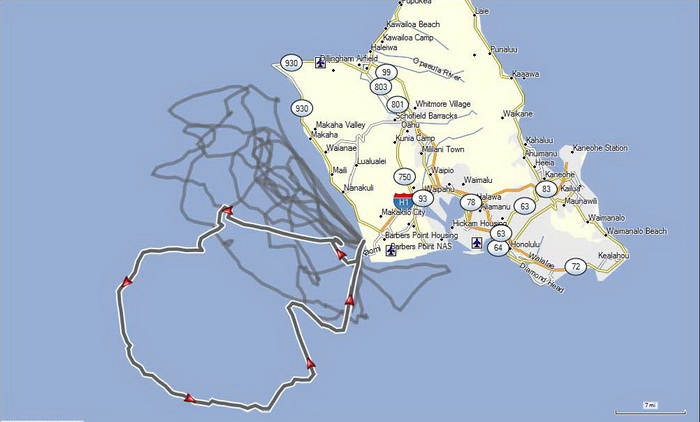
Our tracklines from the last 8 days. Today’s trackline is highlighted – we covered 165 kilometers to the southwest of O‘ahu.
October 17, 2010
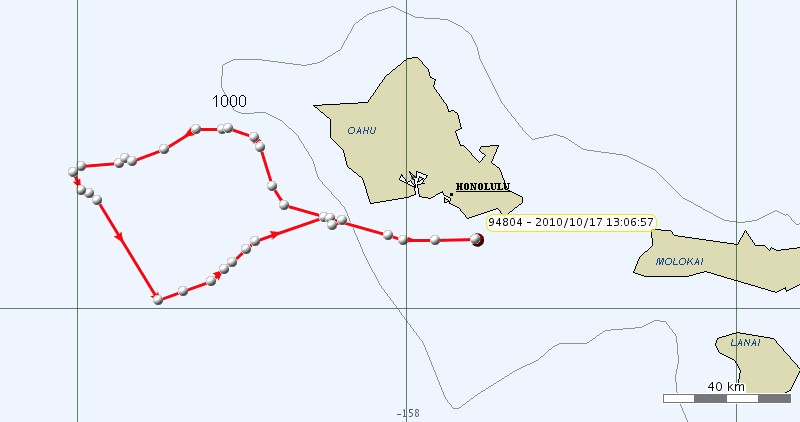
A map showing the movements of the Pseudorca since it was satellite tagged on October 15. The 1000 meter depth contour is shown. The individual has been identified as HIPc200 in our catalog, first seen in December 2004 off the island of Hawai‘i (and seen again in September 2008 off the island of Hawai‘i). Today the group came back close to O‘ahu but moved past the area where we were able to work due to very rough seas off the south shore of O‘ahu.
October 16, 2010

Short-finned pilot whales off Waianae, October 16, 2010. Photo by Daniel Webster
The tagged Pseudorca from yesterday was about 75 kilometers offshore this morning so we surveyed closer to shore and found a dispersed group of about 47 pilot whales, and deployed two more satellite tags to track movements.

A large subadult or small adult short-finned pilot whale off Waianae, October 16, 2010. Photo by Daniel Webster
October 15, 2010
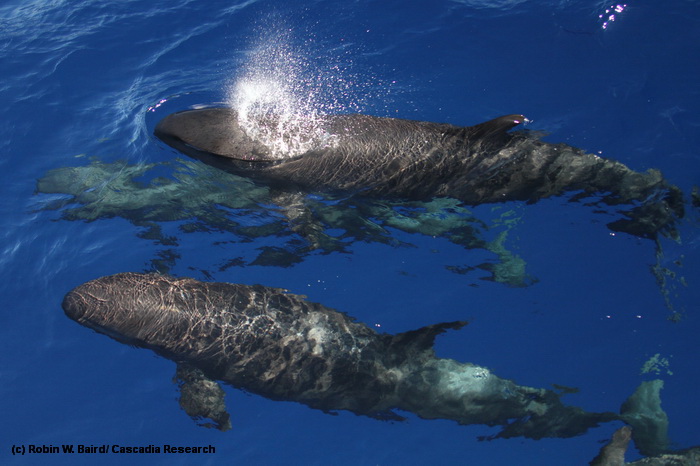
False killer whales, October 15, 2010. Photo by Robin Baird.
A good day on the water. We encountered a group of pilot whales and were able to deploy a satellite tag on one individual. While with the pilot whales a group of false killer whales moved through in the opposite direction, and we left the pilot whales to work with the false killer whales. Although we haven’t yet looked at the photos we think this group is part of the resident “Hawai‘i insular” population of false killer whales.
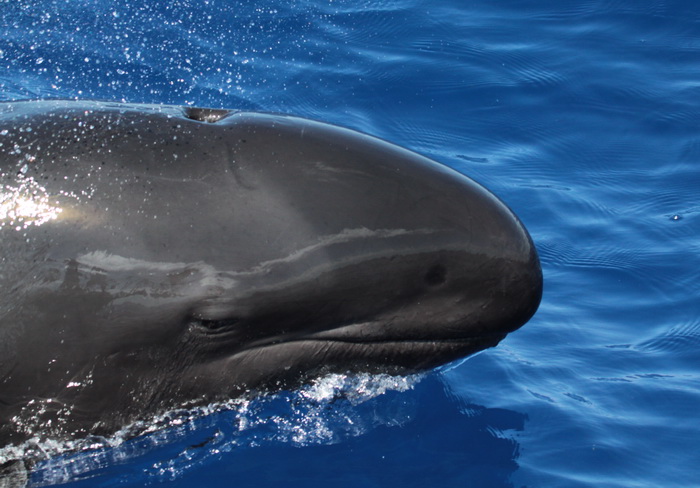
False killer whale, October 15, 2010. Photo by Jessica Aschettino.
We were able to photo-identify about 26 individuals, make one acoustic recording, collect three biopsy samples for genetic and toxicology studies, and deploy one satellite/dive tag. In the past we have collected some short-term information on diving behavior of false killer whales from suction-cup attached time-depth recorders, but this tag (a Wildlife Computers Mk10a tag) will record and transmit information on diving behavior, as well as locations of the whale, for up to several months. For more information on false killer whales in Hawai‘i see our web page for this species.
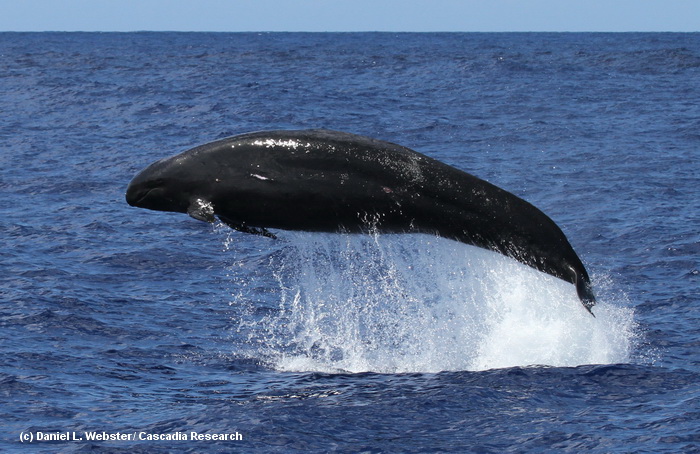
False killer whale, October 15, 2010. Photo by Daniel Webster. This individual is missing the dorsal fin, likely lost through an interaction with fishing gear. We first documented this individual in May 2003, along with two other individuals with dorsal fin disfigurements from line interactions. We published a paper on these individuals and a comparison of such injuries in false killer whales and other species, available here.
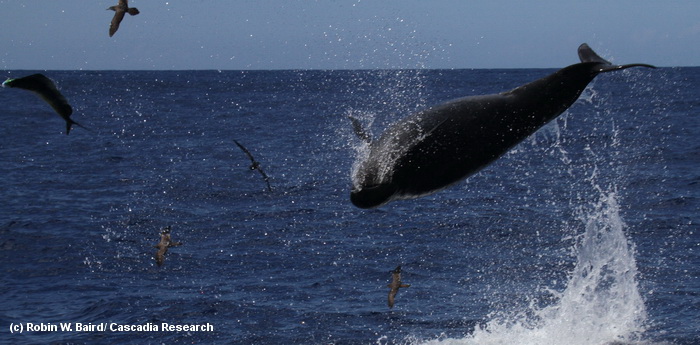
False killer whale and mahimahi, October 15, 2010. Photo by Robin Baird.
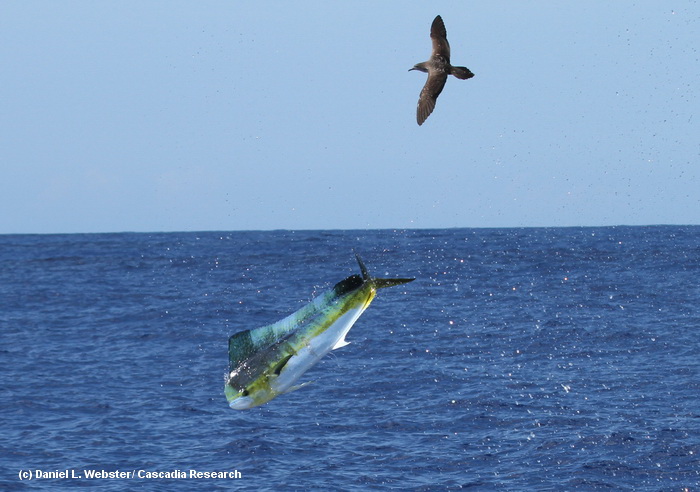
Mahimahi and wedge-tailed shearwater, October 15, 2010. Photo by Daniel Webster. The mahimahi was in the air after being thrown there by a false killer whale.
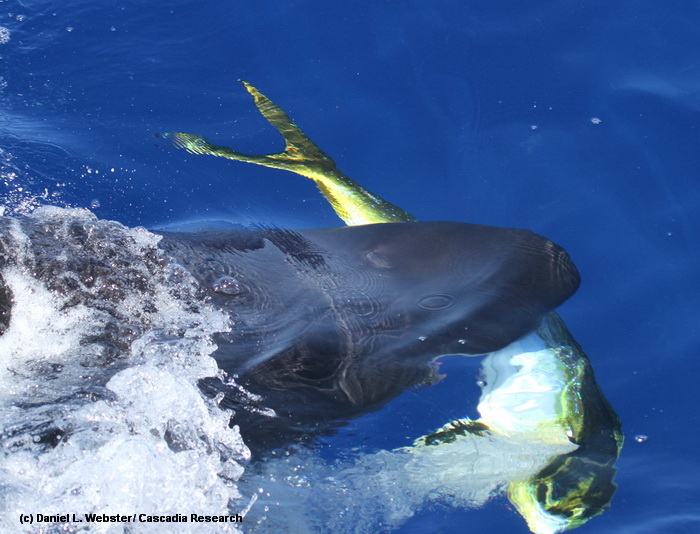
False killer whale with mahimahi, October 15, 2010. Photo by Daniel Webster.
October 14, 2010
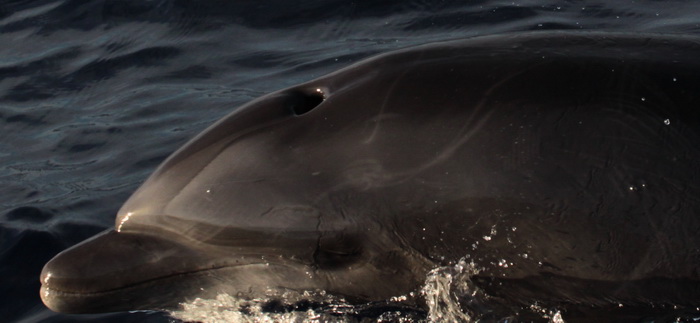
Common bottlenose dolphin off Waianae, October 14. Photo by Jessica Aschettino.
Our fourth day on the water and our fourth species for the trip, a group of about 18 bottlenose dolphins. We were able to get photo-IDs of most individuals and two biopsy samples from the group. From our earlier work on bottlenose dolphins off O‘ahu (in 2002 and 2003) we found no movements of individuals between O‘ahu and any of the other islands in Hawai‘i, indicating a resident population. For more information on bottlenose dolphins in Hawai‘i see our web page for this species.
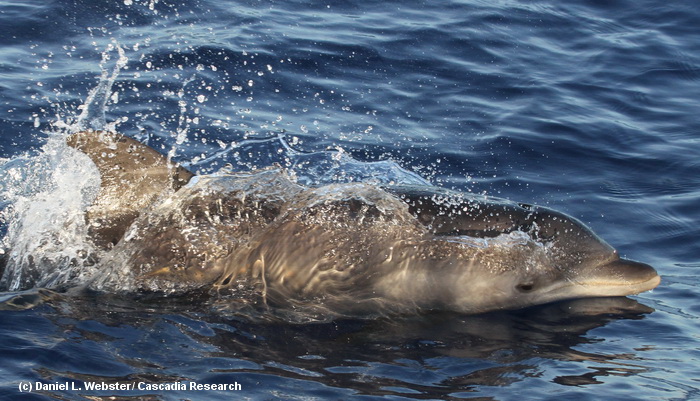
Bottlenose dolphin off Waianae, Photo by Daniel Webster.
October 13, 2010
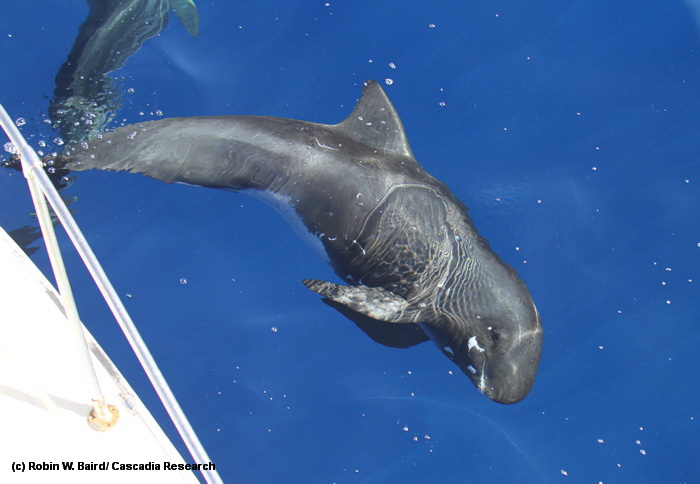
Pygmy killer whale off Waianae, October 13, 2010. Photo by Robin Baird.
Today we encountered one of our high priority species for the trip and one of the rarest species of oceanic dolphins in the world, pygmy killer whales. We were able to obtain photos of all 18 individuals in the group, which we will compare to our photo-identification catalog of this species to assess movements and population structure. Most of our photos are from encounters off the island of Hawaii (see our pygmy killer whale web page), although we have also encountered this species off Ni‘ihau and Lana‘i in the past. We were also able to deploy one satellite tag, and are hoping the tag will give us at least several weeks of movement information. We have satellite tagging data from two individual pygmy killer whales tagged off the island of Hawai‘i (in 2008 and 2009), both of which stayed closely associated with the island for the duration of tag attachment (10 and 22 days).

Pygmy killer whale off Waianae, October 13, 2010. Photo by Robin Baird.
A little bit of background on pygmy killer whales. Pygmy killer whales were first discovered based on two skulls, one described in 1827 and the other in 1874. The species was then effectively lost to science until 1952. The first six times live individuals were documented in the wild are worth reporting. The first live individual known to be of this species was harpooned, off Taiji, Japan, and brought in for processing. Although the individual was quickly flensed almost all the parts were obtained and the external appearance was recreated and described, along with the skeleton. The common name pygmy killer whale was first proposed based on this specimen by Yamada (1954). The second time this species was documented alive in the wild, off Senegal in 1958, the individual was captured and killed. The third known at-sea sighting was of a group of 14 individuals off Japan in 1963 – in this case the entire group was captured and taken into captivity, where all died within 22 days. The fourth recorded at-sea sighting of this species, also in 1963, ended a bit better, when only one individual in the group was captured and taken into captivity, this time in Hawai‘i. The fifth record of a live animal was an individual captured and accidentally killed in a tuna purse seine off Costa Rica in 1967. In the spring of 1969 a live individual was harpooned off St. Vincent. Finally, later in 1969, a group was observed in the Indian Ocean with none of them being killed or captured.
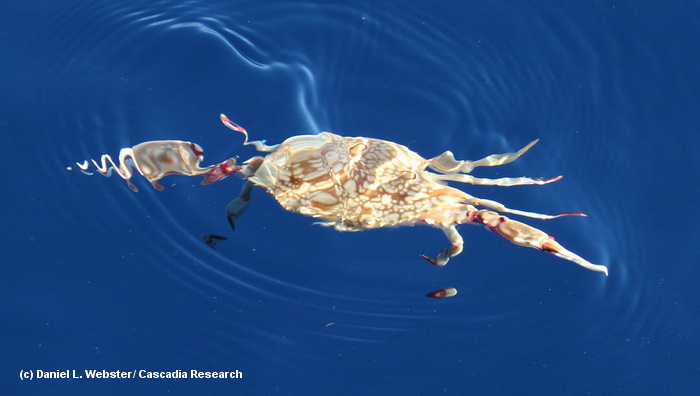
We also found two groups of spotted dolphins offshore and collected three biopsy samples, and observed a Kuahonu Crab (Portunus sanguinolentus) near one of the spotted dolphin groups, at the surface in about 1300 meters of water. This is the first time we’ve seen this species of crab. Photo by Daniel Webster.
October 12, 2010
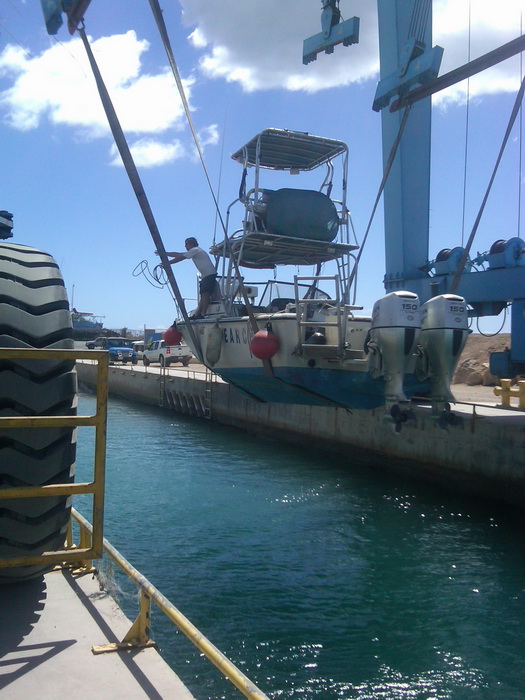
Today was spent dealing with one of the inevitable aspects of operating a boat, unexpected maintenance.
October 11, 2010

Rough-toothed dolphin, October 11, 2010. Photo by Jessica Aschettino. This individual has several sets of tooth rake marks from interactions with other rough-toothed dolphins. Today we had another good encounter with rough-toothed dolphins – we were able to collect four additional biopsy samples as well as identification photos of about 20 individuals.
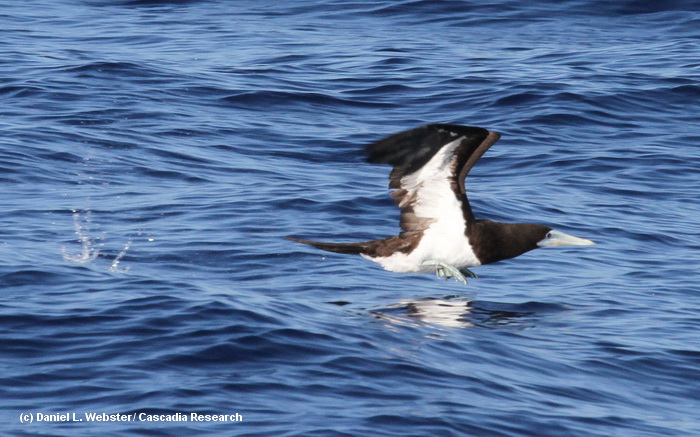
Brown booby off Waianae, October 11, 2010. Photo by Daniel Webster
October 10, 2010
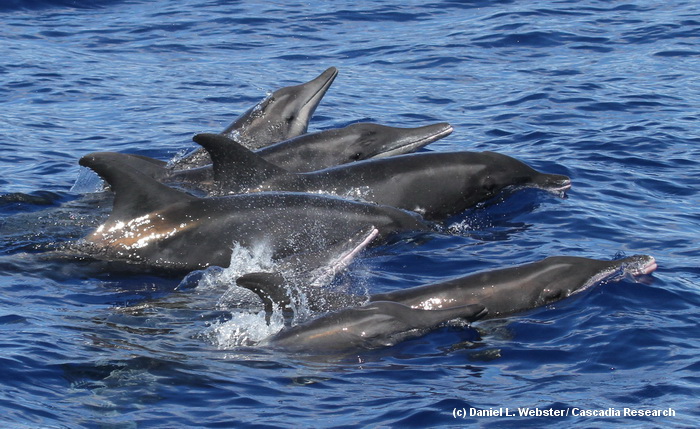
Rough-toothed dolphins off Waianae, October 10, 2010. Photo by Daniel Webster.
Our first day on the water. Despite a forecast of 20 knot winds we were able to find relatively calm water off the Waianae coast for most of the morning, covering almost 90 kilometers of trackline, with two sightings of rough-toothed dolphins and two sightings of pantropical spotted dolphins. We were able to collect biopsy samples from four rough-toothed dolphins. These samples will be contributed to a study of rough-toothed dolphin population genetics being undertaken by Ph.D. student Renee Albertson at Oregon State University as well as to a study of toxicology by M.Sc. student Kerry Foltz at Hawai‘i Pacific University.
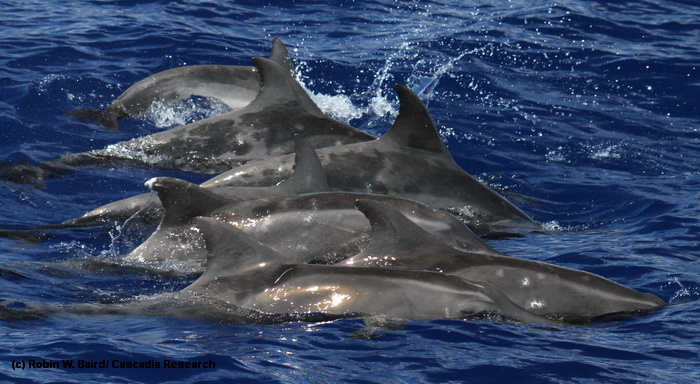
Rough-toothed dolphins off Waianae, October 10, 2010. Photo by Robin Baird. We were also able to obtain identification photos from about 20 individual rough-toothed dolphins which will be contributed to our catalog for this species. From comparisons of photos taken off Kaua‘i and the island of Hawai‘i we have evidence there is little or no interchange between the two areas within the main Hawaiian Islands (see a recent publication and more information on rough-toothed dolphins in Hawai‘i here). These photos will help assess potential boundaries between the two areas.

Pantropical spotted dolphin, October 10, 2010. Photo by Daniel Webster. This individual has a recent wound from a cookie-cutter shark on the back.

Pantropical spotted dolphin with a cookie-cutter shark bite wound on the head, October 10, 2010. Photo by Daniel Webster. We also collected two biopsy samples from spotted dolphins today, which will be used both for toxicology and genetic studies.
October 9, 2010
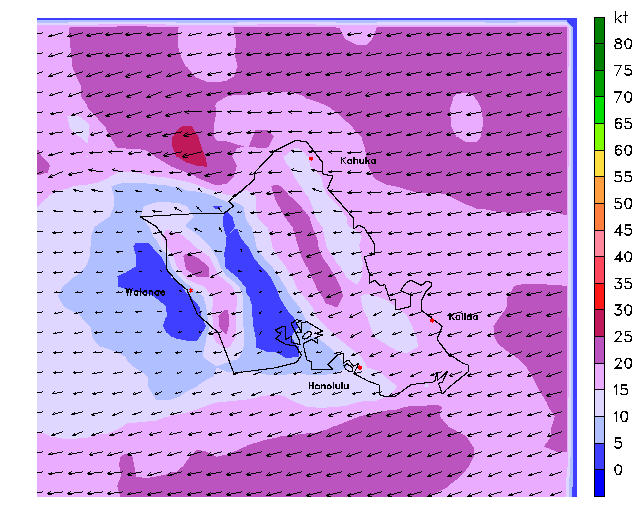
A wind vector forecast map for October 10, 2010, for 0800 HST, from the Haleakala Weather Center
The 27′ Whaler we use for our work off the big island was shipped over to O‘ahu and is now at the dock at Ko‘olina Marina, located at the south end of the Waianae (SW) coast of O‘ahu. Tomorrow we start the project at sunrise.
Photos on this page taken under NMFS Scientific Research Permits (Nos. 731-1774 and 774-1714). All photos are copyrighted and should not be used without permission.